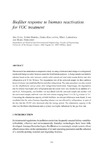Mostrar el registro sencillo del ítem
Biofilter response to biomass reactivation for VOC treatment
| dc.contributor.author | Elías, Ana | es_ES |
| dc.contributor.author | Barona, Astrid | es_ES |
| dc.contributor.author | Gallastegui, Gorka | es_ES |
| dc.contributor.author | Larrañaga, Mikel | es_ES |
| dc.contributor.author | Fernández, María | es_ES |
| dc.date.accessioned | 2014-10-01T10:17:04Z | |
| dc.date.available | 2014-10-01T10:17:04Z | |
| dc.date.issued | 2007 | es_ES |
| dc.identifier.citation | Biotechniques for Air Pollution Control II, 2007: 551-559. ISBN: 978-84-9749-258-4 | es_ES |
| dc.identifier.isbn | 978-84-9749-258-4 | es_ES |
| dc.identifier.uri | http://hdl.handle.net/2183/12852 | |
| dc.description.abstract | [Abstract] This research has undertaken a comparative study on using a fresh activated sludge or a refrigerated/ reactivated sludge as active biomass source for biofiltration purposes. A sludge sample was initially selected based on the ratio between volatile solid content and total solid content before and after refrigeration at 6 oC for 90 days. The degradation rate of the activated sample for three addition doses of toluene was established before and after refrigeration. The same procedure was also carried out for ethylbenzene and p-xylene after refrigeration/reactivation. Surprisingly, the degradation rate for toluene was higher after refrigeration and the results were very similar for an addition of 2 and 8 µL. Subsequently, one biofilter was inoculated with the activated sample and another with the reactivated sample, and both were fed with toluene ranging from 2.6 to 26.2 g toluene m-3 h-1. Concerning the elimination capacity of both biofilters, no relevant differences were found. It was concluded that the active biomass degrading toluene was not affected by refrigeration, in spite of the fact that the SV/ST ratio decreased after the storage period. The elimination capacity of the other two biofilters (ethylbenzene and p-xylene) was highly influenced by the gas flow rate. 1 INTRODUCTION Environmental regulations for pollution control are frequently enacted before «suitable» (affordable, effective and environmentally friendly) technologies have been fully developed. Amongst biotechnologies, biofiltration is a seemingly simple system whose effectiveness relies on the optimization of several operating parameters and the selection of a suitable packing material and degrading biomass | es_ES |
| dc.language.iso | eng | es_ES |
| dc.publisher | Universidade da Coruña | es_ES |
| dc.title | Biofilter response to biomass reactivation for VOC treatment | es_ES |
| dc.type | info:eu-repo/semantics/conferenceObject | es_ES |
| dc.rights.access | info:eu-repo/semantics/openAccess | es_ES |






